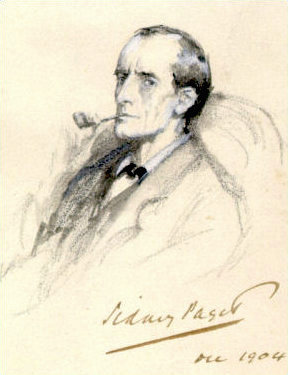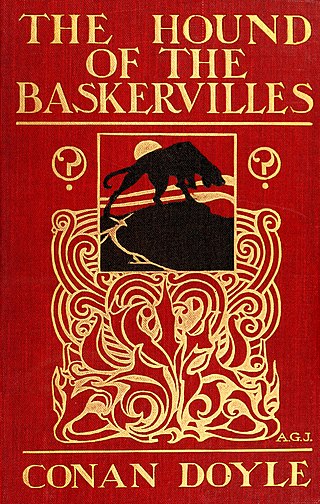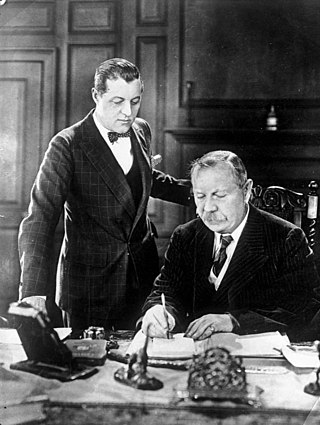
Sherlock Holmes is a fictional detective created by British author Arthur Conan Doyle. Referring to himself as a "consulting detective" in the stories, Holmes is known for his proficiency with observation, deduction, forensic science and logical reasoning that borders on the fantastic, which he employs when investigating cases for a wide variety of clients, including Scotland Yard.

The Hound of the Baskervilles is the third of the four crime novels by British writer Arthur Conan Doyle featuring the detective Sherlock Holmes. Originally serialised in The Strand Magazine from August 1901 to April 1902, it is set in 1889 largely on Dartmoor in Devon in England's West Country and tells the story of Holmes and Watson investigating the case of the legend of a fearsome, diabolical hound of supernatural origin. This was the first appearance of Holmes since his apparent death in "The Final Problem", and the success of The Hound of the Baskervilles led to the character's eventual revival.

John Dickson Carr was an American author of detective stories, who also published using the pseudonyms Carter Dickson, Carr Dickson, and Roger Fairbairn.

Adrian Malcolm Conan Doyle was the youngest son of Sir Arthur Conan Doyle and his second wife Jean, Lady Doyle or Lady Conan Doyle. He had two siblings, sister Jean Conan Doyle and brother Denis, as well as two half-siblings, sister Mary and brother Kingsley.
"The Adventure of the Wax Gamblers" is a Sherlock Holmes short story written in collaboration by Adrian Conan Doyle and John Dickson Carr. The story was published in the 1954 collection The Exploits of Sherlock Holmes. It was first published in Collier's on 20 June 1953, illustrated by Robert Fawcett.
"The Adventure of the Seven Clocks" is a Sherlock Holmes story by Adrian Conan Doyle and John Dickson Carr. The story was published in the 1954 collection The Exploits of Sherlock Holmes. It was first published in Life on 29 December 1952, with illustrations by Adolf Hallman.
"The Adventure of the Gold Hunter" is a Sherlock Holmes murder mystery by Adrian Conan Doyle and John Dickson Carr. The story was published in the 1954 collection The Exploits of Sherlock Holmes. It was first published in Collier's on 30 May 1953, illustrated by Robert Fawcett.
"The Adventure of the Highgate Miracle" is a Sherlock Holmes mystery story written in collaboration by Adrian Conan Doyle and John Dickson Carr. The story was published in the 1954 collection, The Exploits of Sherlock Holmes. It was first published in Collier's on 6 June 1953, illustrated by Robert Fawcett.
"The Adventure of the Black Baronet" is a Sherlock Holmes murder mystery written by Adrian Conan Doyle and John Dickson Carr. The story was published in the 1954 collection The Exploits of Sherlock Holmes. It was first published in Collier's on 23 May 1953, illustrated by Robert Fawcett.
"The Adventure of the Sealed Room" is a Sherlock Holmes murder mystery by Adrian Conan Doyle and John Dickson Carr. The story was published in the 1954 collection The Exploits of Sherlock Holmes. It was first published in Collier's on 13 June 1953, and was illustrated by Robert Fawcett in Collier's.
The stories of Sherlock Holmes by Sir Arthur Conan Doyle have been very popular as adaptations for the stage, and later film, and still later television. The four volumes of the Universal Sherlock Holmes (1995) compiled by Ronald B. De Waal lists over 25,000 Holmes-related productions and products. They include the original writings, "together with the translations of these tales into sixty-three languages, plus Braille and shorthand, the writings about the Writings or higher criticism, writings about Sherlockians and their societies, memorials and memorabilia, games, puzzles and quizzes, phonograph records, audio and video tapes, compact discs, laser discs, ballets, films, musicals, operettas, oratorios, plays, radio and television programs, parodies and pastiches, children's books, cartoons, comics, and a multitude of other items — from advertisements to wine — that have accumulated throughout the world on the two most famous characters in literature."
Sherlock Holmes has long been a popular character for pastiche, Holmes-related work by authors and creators other than Arthur Conan Doyle. Their works can be grouped into four broad categories:

Traditionally, the canon of Sherlock Holmes consists of the 56 short stories and four novels written by Sir Arthur Conan Doyle. In this context, the term "canon" is an attempt to distinguish between Doyle's original works and subsequent works by other authors using the same characters. Usually capitalized by aficionados of the Sherlockian game as "the Canon", the description of these 60 adventures as the Sherlock Holmes canon and the game of applying the methods of "Higher Criticism" to it was started by Ronald Knox as a playful use of the traditional definition of canon as an authoritative list of books accepted as holy scripture.

John H. Watson, known as Dr. Watson, is a fictional character in the Sherlock Holmes stories by Sir Arthur Conan Doyle. Along with Sherlock Holmes, Dr. Watson first appeared in the novel A Study in Scarlet (1887). "The Adventure of Shoscombe Old Place" (1927) is the last work of Doyle featuring Watson and Holmes, although their last appearance in the canonical timeline is in "His Last Bow" (1917).
The Sign of Four (2001) is a Canadian television film directed by Rodney Gibbons and starring Matt Frewer and Kenneth Welsh. The movie is based on Arthur Conan Doyle's second Sherlock Holmes novel published in 1890.
The Hound of the Baskervilles is a Canadian television film directed by Rodney Gibbons and starring Matt Frewer and Kenneth Welsh. The film is based on Arthur Conan Doyle's 1902 Sherlock Holmes novel of the same name.
From 1921 to 1923, Stoll Pictures produced three series of silent black-and-white films based on Sir Arthur Conan Doyle's Sherlock Holmes stories. Forty-five short films and two feature-length films were produced featuring Eille Norwood in the role of Holmes and Hubert Willis cast as Dr. Watson with the exception of the final film, The Sign of Four, where Willis was replaced with Arthur Cullin. Consequently, Norwood holds the record for most appearances as Sherlock Holmes in film.
The Revenge of the Hound is a Sherlock Holmes pastiche novel by Michael Hardwick, originally published in 1987. It is Hardwick's second Holmes novel after 1979's The Prisoner of the Devil.





